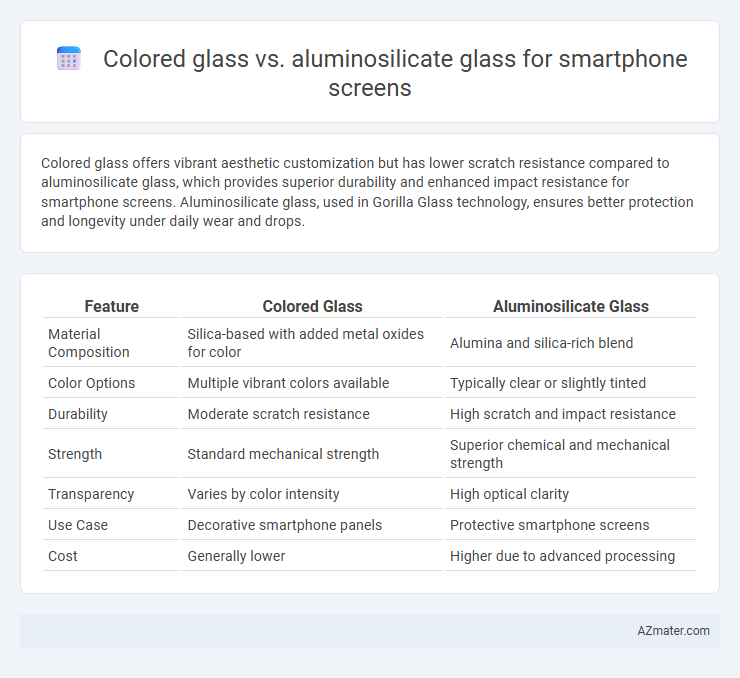Colored glass offers vibrant aesthetic customization but has lower scratch resistance compared to aluminosilicate glass, which provides superior durability and enhanced impact resistance for smartphone screens. Aluminosilicate glass, used in Gorilla Glass technology, ensures better protection and longevity under daily wear and drops.
Table of Comparison
| Feature | Colored Glass | Aluminosilicate Glass |
|---|---|---|
| Material Composition | Silica-based with added metal oxides for color | Alumina and silica-rich blend |
| Color Options | Multiple vibrant colors available | Typically clear or slightly tinted |
| Durability | Moderate scratch resistance | High scratch and impact resistance |
| Strength | Standard mechanical strength | Superior chemical and mechanical strength |
| Transparency | Varies by color intensity | High optical clarity |
| Use Case | Decorative smartphone panels | Protective smartphone screens |
| Cost | Generally lower | Higher due to advanced processing |
Introduction to Smartphone Screen Materials
Smartphone screens primarily use aluminosilicate glass, such as Gorilla Glass, due to its high impact resistance and scratch durability. Colored glass, while offering aesthetic customization, typically lacks the mechanical strength and chemical toughness required for daily smartphone use. The choice of screen material significantly affects the device's longevity, visual clarity, and user experience.
What is Colored Glass?
Colored glass for smartphone screens is glass that has been infused with metal ions or compounds to produce specific hues, enhancing aesthetic appeal and reducing glare without compromising clarity. It differs from aluminosilicate glass, which is primarily engineered for extreme durability and scratch resistance through chemical strengthening processes. While colored glass emphasizes visual customization and tint effects, aluminosilicate glass focuses on structural robustness and high damage tolerance.
What is Aluminosilicate Glass?
Aluminosilicate glass, a type of chemically strengthened glass, is composed primarily of aluminum oxide and silicon dioxide, offering exceptional durability and resistance to scratches and impacts. Unlike colored glass, which is mainly used for aesthetic purposes, aluminosilicate glass provides superior strength and clarity, making it ideal for smartphone screens that require both toughness and high transparency. Its superior performance in drop and scratch tests has made aluminosilicate glass the preferred material in premium smartphones, ensuring enhanced protection and longevity.
Strength and Durability Comparison
Aluminosilicate glass outperforms colored glass in smartphone screen strength due to its superior scratch resistance, impact durability, and ability to withstand bending stress. Its chemically strengthened composition, especially in brands like Gorilla Glass, provides enhanced protection against drops and everyday wear compared to the more brittle colored glass variants. While colored glass offers aesthetic customization, aluminosilicate glass ensures longer-lasting durability, making it the preferred choice for high-performance smartphone displays.
Scratch Resistance: Colored vs Aluminosilicate Glass
Aluminosilicate glass offers superior scratch resistance compared to colored glass, due to its chemically strengthened composition and higher surface hardness. Colored glass often incorporates dyes and pigments that can reduce its overall durability and increase susceptibility to surface abrasions. For smartphone screens, aluminosilicate glass is preferred for maintaining clarity and longevity under daily wear.
Optical Clarity and Color Reproduction
Colored glass for smartphone screens often exhibits reduced optical clarity and altered color reproduction due to the presence of tints or dyes that filter light transmission. Aluminosilicate glass, commonly used in premium smartphones, offers superior optical clarity and true-to-life color reproduction because of its chemically strengthened structure and high transparency. The absence of coloration in aluminosilicate glass ensures consistent brightness and accurate color representation, enhancing visual experience and display performance.
Impact Resistance and Drop Protection
Colored glass for smartphone screens typically offers aesthetic customization but tends to have lower impact resistance compared to aluminosilicate glass. Aluminosilicate glass, such as Gorilla Glass, provides superior drop protection due to its chemically strengthened structure, making it more resistant to scratches and shattering. The enhanced durability of aluminosilicate glass significantly reduces screen damage upon accidental drops, thereby extending the lifespan of the smartphone display.
Cost and Manufacturing Considerations
Colored glass for smartphone screens generally incurs higher manufacturing costs due to the complex pigmentation process that can affect optical clarity and requires specialized coatings. Aluminosilicate glass, widely used in flagship smartphones, offers superior durability and scratch resistance at a lower cost because of established mass production techniques and high material availability. The choice between the two impacts overall production expenses, with aluminosilicate glass favored for cost efficiency and performance in large-scale manufacturing.
Environmental and Sustainability Factors
Colored glass in smartphone screens often involves additional chemical treatments and dyes that can increase environmental impact due to resource-intensive manufacturing and challenges in recycling. Aluminosilicate glass, known for its durability and scratch resistance, typically offers better longevity, reducing the need for frequent replacements and contributing to sustainability through enhanced product lifespan. Recycling processes for aluminosilicate glass are generally more established, resulting in lower environmental footprints compared to colored glass, which may complicate material recovery efforts.
Which Glass is Best for Your Smartphone?
Aluminosilicate glass offers superior strength and scratch resistance compared to colored glass, making it the best choice for smartphone screens that require durability and clarity. Colored glass provides aesthetic customization but lacks the mechanical resilience to withstand daily impacts and abrasions effectively. For optimal protection and longevity, aluminosilicate glass remains the preferred material in high-end smartphones.

Infographic: Colored glass vs Aluminosilicate glass for Smartphone screen
 azmater.com
azmater.com